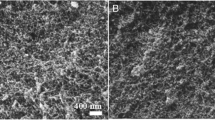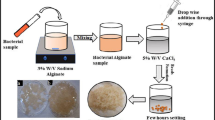Abstract
Encapsulation of recombinant Escherichia coli cells expressing a biocatalyst has the potential to produce stable, long-lasting enzyme activity that can be used for numerous applications. The current study describes the use of this technology with recombinant E. coli cells expressing the atrazine-dechlorinating enzyme AtzA in a silica/polymer porous gel. This novel recombinant enzyme-based method utilizes both adsorption and degradation to remove atrazine from water. A combination of silica nanoparticles (Ludox TM40), alkoxides, and an organic polymer was used to synthesize a porous gel. Gel curing temperatures of 23 or 45 °C were used either to maintain cell viability or to render the cells non-viable, respectively. The enzymatic activity of the encapsulated viable and non-viable cells was high and extremely stable over the time period analyzed. At room temperature, the encapsulated non-viable cells maintained a specific activity between (0.44 ± 0.06) μmol/g/min and (0.66 ± 0.12) μmol/g/min for up to 4 months, comparing well with free, viable cell-specific activities (0.61 ± 0.04 μmol/g/min). Gels cured at 45 °C had excellent structural rigidity and contained few viable cells, making these gels potentially compatible with water treatment facility applications. When encapsulated, non-viable cells were assayed at 4 °C, the activity increased threefold over free cells, potentially due to differences in lipid membranes as shown by FTIR spectroscopy and electron microscopy.





Similar content being viewed by others
References
Acero JL, Stemmler K, Gunten Uv (2000) Degradation kinetics of atrazine and its degradation products with ozone and OH radicals: a predictive tool for drinking water treatment. Environ Sci Technol 34:591–597
Acosta EJ, Steffensen MB, Tichy SE, Simanek EE (2004) Removal of water using covalent sequestration. J Agric Food Chem 52:545–549
Avnir D, Coradin T, Lev O, Livage J (2006) Recent bio-applications of sol–gel materials. J Mater Chem 16:1013–1030
Bottero JY, Khatib K, Thomas F, Jucker K, Bersillon JL, Mallevialle J (1994) Adsorption of atrazine onto zeolites and organoclays, in the presence of background organics. Water Res 28:483–490
de Souza ML, Wackett LP, Boundy-Mills KL, Mandelbaum RT, Sadowsky MJ (1995) Cloning, characterization and expression of a gene region from Pseudomonas sp. strain ADP involved in the dechlorination of atrazine. Appl Environ Microbiol 61:3373–3378
Depagne C, Roux C, Coradin T (2011) How to design cell-based biosensors using the sol–gel process. Anal Bioanal Chem 400:965–976
Devitt E, Wiesner MR (1998) Dialysis investigations of atrazine–organic matter interactions and the role of a divalent metal. Environ Sci Technol 32:232–237
Doulia D, Hourdakis A, Rigas F, Anagnostopoulus E (1997) Removal of atrazine from water by use of nonionic polymeric resins. J Environ Sci Health, Part A 32:2635–2656
Eisenthal R, Peterson ME, Daniel RM, Danson MJ (2006) The thermal behavior of enzyme activity: implications for biotechnology. Trends Biotechnol 24:289–292
Ferrer ML, Yuste L, Rojo F, del Monte F (2003) Biocompatible sol–gel route for encapsulation of living bacteria in organically modified silica matrices. Chem Mater 15:3614–3618
Goswami K, Green RE (1971) Microbial degradation of the herbicide atrazine and its 2-hydroxyanalog in submerged soils. Environ Sci Technol 5:426–429
Govantes F, Porrúa O, García-González V, Santero E (2009) Atrazine biodegradation in the lab and in the field: enzymatic activities and gene regulation. J Microbiol Biotechnol 2:178–185
Hosticka B, Norris PM, Brenizer JS, Daitch CE (1998) Gas flow through aerogels. J Non-Cryst Solids 225:293–297
Kauffmann C, Mandelbaum RT (1998) Entrapment of atrazine chlorohydrolase in sol–gel glass matrix. J Biotechnol 62:168–176
Le Baron HM, McFarland JE, Burnside OC (2008) The Triazine Herbicides: 50 Years Revolutionizing Agriculture. Elsevier, Oxford, UK
Lima D, Viana P, Andre S, Chelinho S, Costa C, Ribeiro R, Sousa JP (2009) Evaluating a bioremediation tool for atrazine contaminated soils in open soil microcosms: the effectiveness of bioaugmentation and biostimulation approaches. Chemosphere 74:187–192
Lin CH, Lerch RN, Kremer RJ, Garret HE (2011) Stimulated rhizodegradation of atrazine by selected plant species. J Environ Qual 40:1113–1121
Livage J, Coradin T, Roux C (2001) Encapsulation of biomolecules in silica gels. J Phys Condens Matter 13:R673–R691
Macias-Flores A, Tafoya-Garnica A, Ruiz-Ordaz N, Salmeron-Alcocer A, Juarez-Ramirez C, Ahuatzi-Chacon D, Mondragon-Parada ME, Galindez-Mayer J (2009) Atrazine biodegradation by a bacterial community immobilized in two types of packed-bed biofilm reactors. World J Microbiol Biotechnol 25:1995–2204
Majewska-Nowak K, Kabsch-Korutowicz M, Dodz M, Winnicki T (2002) The influence of organic carbon concentration on atrazine removal by UF membranes. Desalination 147:177–122
Mandelbaum RT, Wackett LP, Allan DL (1993) Rapid hydrolysis of atrazine to hydroxyatrazine by soil bacteria. Environ Sci Technol 27:1943–1946
Mandelbaum RT, Allan DL, Wackett LP (1995) Isolation and characterization of a Pseudomonas sp. that mineralizes the s-triazine herbicide atrazine. Appl Environ Microbiol 61:1451–1457
Martinez B, Tomkins J, Wackett LP, Wing R, Sadowsky M (2001) Complete nucleotide sequence and organization of the atrazine catabolic plasmid pADP-1 from Pseudomonas sp. strain ADP. J Bacteriol 183:5684–5697
Nassif N, Bouvet O, Rager MN, Roux C, Coradin T, Livage J (2002) Living bacteria in silica gels. Nat Mater 1:42–44
Nassif N, Roux C, Coradin T, Bouvet OMM, Livage J (2004) Bacteria quorum sensing in silica matrix. J Mater Chem 14:2264–2268
Parra S, Stanca SE, Guasaquillo I, Thampi KR (2004) Photocatalytic degradation of atrazine using suspended and supported TiO2. Appl Catal, B 51:107–116
Pelekani C, Snoeyink VL (2000) Competitive adsorption between atrazine and methylene blue on activated carbon: the importance of pore size distribution. Carbon 38:1423–1436
Perullini M, Amoura M, Roux C, Coradin T, Livage J, Japas ML, Jobbagy M, Bilmes SA (2011) Improving silica matrices for encapsulation of Escherichia coli using osmoprotectors. J Mater Chem 21:4546–4552
Reátegui E, Aksan A (2009) Effects of the low temperature transitions of confined water on the structure of isolated and cytoplasmic proteins. J Phys Chem B 113:13048–13060
Reátegui E, Aksan A (2010) Effects of water on the structure and low/high temperature stability of confined proteins. Phys Chem Chem Phys 12:10161–10172
Rietti-Shati M, Ronen D, Mandelbaum RT (1996) Atrazine degradation by Pseudomonas strain ADP entrapped in sol–gel glass. J Sol-Gel Sci Technol 7:77–79
Sambrook J, Fritsch EF, Maniatis T (1989) Molecular cloning; A Laboratory Manual, 2nd Ed. Cold Spring Harbor Laboratory Press, Cold Spring Harbor, NY
Scott C, Lewis SE, Milla R, Taylor MC, Rodgers AJW, Dumsday G, Brodie JE, Oakeshott JG, Russell RJ (2010) A free-enzyme catalyst for the bioremediation of environmental atrazine contamination. J Environ Manag 91:2075–2078
Seffernick JL, Reynolds E, Fedorov AA, Fedorov E, Almo SC, Sadowsky MJ, Wackett LP (2010) X-ray structure and mutational analysis of the atrazine chlorohydrolase TrzN. J Biol Chem 285:30606–30614
Silva E, Fialho AM, Sá-Correia I, Burns RG, Shaw LJ (2004) Combined bioaugmentation and biostimulation to cleanup soil contaminated with high concentrations of atrazine. Environ Sci Technol 38:632–637
Strong LC, McTavish H, Sadowsky MJ, Wackett LP (2000) Field-scale remediation of atrazine-contaminated soil using recombinant Escherichia coli expressing atrazine chlorohydrolase. Environ Microbiol 2:91–98
Topp E, Mulbry WM, Zhu H, Nour SM, Cuppels D (2000) Characterization of s-triazine herbicide metabolism by a Nocardioides sp. isolated from agricultural soils. Appl Environ Microbiol 66:3134–3141
Wang L, Samac DA, Shapir N, Wackett LP, Vance CP, Olszewski NE, Sadowsky MJ (2005) Biodegradation of atrazine in transgenic plants expressing a modified bacterial atrazine chlorohydrolase (atzA) gene. J Plant Biotechnol 3:475–486
Yue Z, Economy J, Rajagopalan K, Bordson G, Piwoni M, Ding L, Snoeyink VL, Marinas BJ (2006) Chemical activated carbon on a fiberglass substrate for removal of trace atrazine from water. J Mater Chem 16:3375–3380
Zhu L, Ma T, Wang J, Xie H, Wang J, Xin C, Shao B (2011) Enhancement of atrazine removal by free and immobilized Arthrobacter sp. HB-5 in soil and wastewater. Soil Sediment Contam 20:87–97
Acknowledgements
We thank Mr. Baris Mutlu for his help in conducting experiments. This research was supported by a National Science Foundation grant (CBET-0644784) to AA, a research grant from Syngenta Crop Protection to LW, MS, and AA, and a seed grant to AA and LW from the BioTechnology Institute at University of Minnesota.
Author information
Authors and Affiliations
Corresponding author
Electronic supplementary material
Below is the link to the electronic supplementary material.
ESM 1
(DOC 74 kb)
Rights and permissions
About this article
Cite this article
Reátegui, E., Reynolds, E., Kasinkas, L. et al. Silica gel-encapsulated AtzA biocatalyst for atrazine biodegradation. Appl Microbiol Biotechnol 96, 231–240 (2012). https://doi.org/10.1007/s00253-011-3821-2
Received:
Revised:
Accepted:
Published:
Issue Date:
DOI: https://doi.org/10.1007/s00253-011-3821-2




